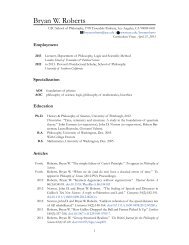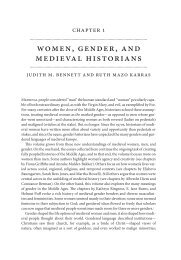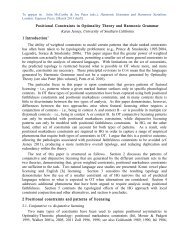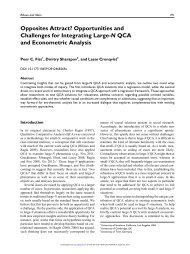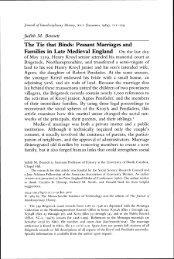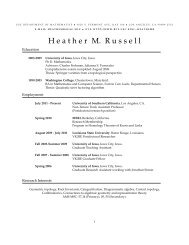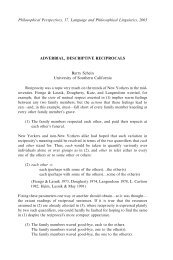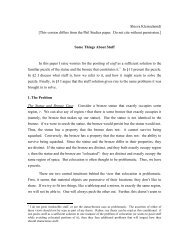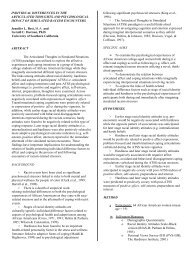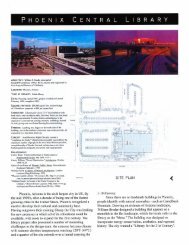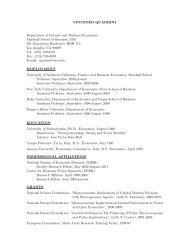Shieva Kleinschmidt University of Southern California At It Again ...
Shieva Kleinschmidt University of Southern California At It Again ...
Shieva Kleinschmidt University of Southern California At It Again ...
You also want an ePaper? Increase the reach of your titles
YUMPU automatically turns print PDFs into web optimized ePapers that Google loves.
<strong>At</strong> <strong>It</strong> <strong>Again</strong>: Time-Travel And Motion<br />
<strong>Shieva</strong> <strong>Kleinschmidt</strong><br />
<strong>University</strong> <strong>of</strong> <strong>Southern</strong> <strong>California</strong><br />
The <strong>At</strong>-<strong>At</strong> account <strong>of</strong> motion has become extremely popular. First championed by<br />
Bertrand Russell in The Principles <strong>of</strong> Mathematics, it can be roughly stated as the view<br />
that: necessarily, something moves if and only if it’s at one place at one time, and at a<br />
distinct place at a distinct time. This, many believe, is all that motion consists in. I think<br />
this is incorrect. In this paper, I’ll present a case in which, intuitively, motion does not<br />
occur, though the <strong>At</strong>-<strong>At</strong> account <strong>of</strong> motion entails that it does. I will then turn to the only<br />
tenable response that avoids revising the <strong>At</strong>-<strong>At</strong> account: denying the possibility <strong>of</strong> my<br />
case. I will argue that the response is both contentious (since the possibility <strong>of</strong> my case is<br />
plausible and useful) and fails to defend the spirit <strong>of</strong> the <strong>At</strong>-<strong>At</strong> account qua reduction <strong>of</strong><br />
motion (rather than merely a listing <strong>of</strong> necessary and sufficient conditions for motion’s<br />
occurring). Since other responses require amending the <strong>At</strong>-<strong>At</strong> account, I will conclude<br />
that, in light <strong>of</strong> the case I present, one cannot accept the <strong>At</strong>-<strong>At</strong> account without<br />
amendment, especially when it is taken as a claim about what it means to move.<br />
1. The Cases<br />
Consider the following two cases. In the first, time-travelling Tom sits quietly from noon<br />
through 1:00pm in the living room. Then Tom time-travels back, and sits quietly from<br />
noon through 1:00pm in the kitchen. The case can be represented as follows:<br />
The Dull Case
Intuition tells us that there is not motion in this case (at least, not during the interval<br />
between and including noon and 1:00pm 1 ). But now consider this second case:<br />
Time-travelling Tom has become adept at running his time machine. Sitting in<br />
the living room waiting to watch Extreme Engineering, Tom realises that he would like<br />
some cookies. So he time-travels to be in the kitchen at 1:00pm, grabs a bunch <strong>of</strong> freshly<br />
baked cookies, time-travels to be in the kitchen at noon, bakes the cookies, and then time-<br />
travels to be in the living-room at 1, to watch his programme. This case can be<br />
represented thus:<br />
The Exciting Case<br />
Intuitively, there is motion in this case in the interval between and including noon and<br />
1:00pm. Even excluding facts about cookie-grabbing and cookie-making and time-travel<br />
machine operating, we think it is clear that Tom moves.<br />
Our intuitions about the cases seem to be grasping onto whatever it is that the<br />
arrows in the above diagrams represent. In spite <strong>of</strong> the fact that, in the two cases, Tom<br />
occupies the same regions (the living room at noon and 1:00pm, and the kitchen at noon<br />
and 1:00pm), we think he moves in one case and not the other. This, however, poses a<br />
problem for accounts that entail the following:<br />
• Motion Supervenience: Necessarily, facts about motion are determined by the<br />
location facts and the identity facts.<br />
1 We can even present a version <strong>of</strong> this case which lacks motion outside <strong>of</strong> this interval as well. Time<br />
travel needn’t require motion (let alone discontinuous motion) if it’s possible for spacetime to be bent and<br />
looped in certain ways. For instance, imagine that Tom is living in a manifold which is twisted and looped<br />
like a möbius strip. If the loop is temporally shorter than Tom’s life, he can simply sit and wait, and appear<br />
at the same time twice in different places.
The most popular account entailing Motion Supervenience is the <strong>At</strong>-<strong>At</strong> account <strong>of</strong><br />
motion. Is there a way <strong>of</strong> reading this account that will enable us to respect our intuitions<br />
about the motion facts in the above cases?<br />
2. The <strong>At</strong>-<strong>At</strong> Account <strong>of</strong> Motion<br />
Bertrand Russell presents us with this account <strong>of</strong> motion: “Motion consists merely in the<br />
occupation <strong>of</strong> different places at different times . . .” 2 That is:<br />
• (<strong>At</strong>-<strong>At</strong>) Necessarily, for any x, x is in motion iff there exist spatial regions s1 and s2,<br />
and times t1 and t2, such that s1 is distinct from s2, t1 is distinct from t2, and x is<br />
at s1 at t1, and at s2 at t2. 3<br />
In other words, objects move if and only if they’re at different places at different times.<br />
<strong>It</strong>’s clear that all the account appeals to in giving the necessary and sufficient conditions<br />
for motion are facts about the identity and location <strong>of</strong> objects.<br />
However, there are a lot <strong>of</strong> kinds <strong>of</strong> location facts. The <strong>At</strong>-<strong>At</strong> account tells us<br />
simply that what matters is where objects are at. To understand the <strong>At</strong>-<strong>At</strong> account, we<br />
must understand what this use <strong>of</strong> ‘at’ amounts to.<br />
2 Russell 1903, Ch. LIV section 447. One may worry (here as well as throughout this paper) about my<br />
reidentifying regions: making identity claims about spatial regions at different times, and temporal regions<br />
at different places. For doing this, I hope to appeal to nothing more than what is appealed to frequently in<br />
common discourse: people <strong>of</strong>ten talk <strong>of</strong>, e.g., returning to the same place, or leaving a location. We can, if<br />
we’d like, interpret them as making relative reidentifications <strong>of</strong> regions (e.g., “I’m in the same region<br />
relative to the room, as I was yesterday”). The central claims in this paper should be unaffected. (Thanks to<br />
Frank Arntzenius for bringing this worry, and the relativisation response, to my attention.)<br />
3 Russell also thought that all motion has to be continuous; hence, only certain types <strong>of</strong> series’ <strong>of</strong> spaces<br />
and times being occupied by an object would qualify that object as a mover. So the <strong>At</strong>-<strong>At</strong> account as<br />
formulated above doesn’t actually reflect Russell’s complete view <strong>of</strong> motion, but rather is a fragment <strong>of</strong> his<br />
view. But I think the <strong>At</strong>-<strong>At</strong> fragment does a better job <strong>of</strong> tracking our intuitions about strange cases.<br />
Consider, for example, how you’d react if you came into the presence <strong>of</strong> a goblin, who (it appears) can<br />
teletransport from one region to the next. When you naively mention to the goblin you’re on your way to<br />
the kitchen for a cookie, the goblin pops out <strong>of</strong> presence where you are, and pops into presence in the<br />
kitchen to get the cookie first. When asked why you didn’t get dessert, a natural response would be: “I<br />
wasn’t fast enough – some goblin got to it before I did.” That is, intuitively, the goblin moved to the<br />
kitchen, though discontinuously. (Discontinuous motion is portrayed all over in popular culture. I Dream <strong>of</strong><br />
Jeannie provides a good example.) Further, apart from fanciful cases like those, science may be pushing us<br />
to posit actual instances <strong>of</strong> discontinuous motion, with electrons making quantum leaps between energylevels<br />
and such (though the implications <strong>of</strong> quantum leaps are difficult to make out due to worries about<br />
wave/particle duality). Still, regardless <strong>of</strong> whether it should be preferred, it is the <strong>At</strong>-<strong>At</strong> account, rather than<br />
Russell’s full account, that is so <strong>of</strong>ten assumed to be the correct account <strong>of</strong> motion. And finally, the<br />
problematic case I discuss can be altered to involve continuous persistence, thereby raising a problem for<br />
Russell’s full account as well (though it’s worth noting that Russell’s statements in The Principles <strong>of</strong><br />
Mathematics strongly suggest that he would simply reject the possibility <strong>of</strong> my case). I will now set aside<br />
Russell’s full account without guilt.
Since the account is about motion <strong>of</strong> objects across space, the most natural<br />
reading <strong>of</strong> the account is as concerning the location <strong>of</strong> entire objects at times. However,<br />
what this amounts to will depend on what one thinks about persistence <strong>of</strong> objects through<br />
time. For the three-dimensionalist, it will amount to concerning the location <strong>of</strong> entire<br />
objects (though some may think that these facts are only expressible with some kind <strong>of</strong><br />
indexing to times; this issue shouldn’t be important for my paper, so I will set it aside).<br />
For four-dimensionalists, it will amount to concerning the location <strong>of</strong> entire temporal-<br />
parts, namely those temporal parts that are entirely present at the time in question. 4<br />
my two cases?<br />
Armed with our reading <strong>of</strong> ‘at’, what are the relevant location and identity facts in<br />
3. The Cases Revisited<br />
For ease <strong>of</strong> discussion, let’s label the locations and occupants <strong>of</strong> those locations as<br />
follows:<br />
4 Two other options for the interpretation <strong>of</strong> ‘at’ are: (i) ‘at’ means has a part present at; and (ii) ‘at’ means<br />
is such that the entire object is located at. The first option fails due to it causing the <strong>At</strong>-<strong>At</strong> account to give<br />
the result that an intuitively stationary blackboard is moving in virtue <strong>of</strong> its having one part at the right side<br />
<strong>of</strong> the room, and another part at the left side <strong>of</strong> the room. (These options, and the worry about the first<br />
option, were presented to me by Hud Hudson.)<br />
For the three-dimensionalist, who takes objects to be entirely present at each time, the second<br />
option will amount to the one I mentioned as the natural reading <strong>of</strong> what the <strong>At</strong>-<strong>At</strong> Account is concerned<br />
with. However, for those who reject Three-Dimensionalism (among whom are the four-dimensionalists,<br />
though others might reject both views), this option will come apart from the reading I prefer.<br />
For the four-dimensionalist, the <strong>At</strong>-<strong>At</strong> Account is not plausible on the second reading, because,<br />
generally, fourdimensionalists think ordinary objects are each entirely located in exactly one region. For<br />
stage theorists, this is a spatial part <strong>of</strong> an instantaneous sliver <strong>of</strong> spacetime; ordinary objects never, strictly<br />
speaking, are present at more than one time, and thus cannot ever meet the conditions for motion given by<br />
the <strong>At</strong>-<strong>At</strong> account on the second reading. For the worm-theorist, objects are entirely located at four (or<br />
more) dimensional regions <strong>of</strong> spacetime. If they were to meet the <strong>At</strong>-<strong>At</strong> Account’s conditions for motion,<br />
then, it would be in virtue <strong>of</strong> a single object being entirely located at more than one <strong>of</strong> these spacetime<br />
chunks. This, however, would conflict with intuitions about what motion occurs in virtue <strong>of</strong>, and it would<br />
fail to capture many cases which we believe involve motion in spite <strong>of</strong> not meeting these conditions.
We want to say that there is some sense in which Tom is at each <strong>of</strong> the locations L1-L4.<br />
But what is it in virtue <strong>of</strong> that Tom persists across time and space? We may answer this<br />
question in a variety <strong>of</strong> ways, though in what follows I’ll focus just on what I take to be<br />
the most mainstream answers to this question. These answers each produce views which<br />
lead to one <strong>of</strong> the following two answers to the question “Where is Tom at each time?”:<br />
(i) Tom is entirely in the kitchen, and also entirely in the living room, and (ii) Tom is<br />
entirely in the fusion <strong>of</strong> the occupied regions in the living room and kitchen, but is not<br />
entirely in either <strong>of</strong> those two proper subregions. To illustrate, consider the various<br />
(mainstream) ways <strong>of</strong> answering the question <strong>of</strong> how Tom persists across time and space:<br />
First, we might think that objects are present at more than one time or place in<br />
virtue <strong>of</strong> having a proper (temporal) part that is entirely present at each time, and<br />
similarly, that an object is present at more than one spatial region in virtue <strong>of</strong> having a<br />
proper spatial part at each proper subregion <strong>of</strong> the region the object occupies at a time. 5<br />
With this account, we would say that A, B, C, D and Tom are all distinct from one<br />
another, but that Tom has a temporal part, Tom1, which is identical to the fusion <strong>of</strong> A and<br />
C, AC, and another temporal part, Tom2, which is identical to the fusion <strong>of</strong> B and D, BD.<br />
The answer to the question “Where is Tom at each time?” is interpreted as being a<br />
question about Tom’s temporal parts, which are located in the same region at each time:<br />
the fusion <strong>of</strong> the occupied region <strong>of</strong> the kitchen, and the occupied region <strong>of</strong> the living<br />
room.<br />
5 This view <strong>of</strong> persistance across space and time is called Pertension, and is presented in Hud Hudson<br />
2006, pp. 99-103. He presents it as: “‘x pertends’ =df x is a material object that is entirely located at a nonpoint-sized<br />
region, r, and for each proper subregion <strong>of</strong> r, r*, x has a proper part entirely located at r*.”<br />
I worry about this definition, however. <strong>It</strong> is presented as describing the kind <strong>of</strong> spatial extension it<br />
is most natural for a four-dimensionalist to posit, because it is analogous to the four-dimensionalist’s<br />
conception <strong>of</strong> temporal extension, and four-dimensionalists are generally very sympathetic to (and find<br />
support for their view in) analogies between space and time. However, positing this kind <strong>of</strong> extension<br />
requires accepting a more liberal view <strong>of</strong> which regions can be occupied, as well as a more liberal view <strong>of</strong><br />
decomposition, than even many four-dimensionalists may be comfortable with.<br />
Unfortunately, it is not clear to me how a view about persistance across space can be stated in a<br />
way that both avoids the requirement <strong>of</strong> these liberal principles, and also precludes coextension with the<br />
spanning view, on which objects are present at more than one region iff the region is a proper subregion <strong>of</strong><br />
the region the entity is entirely present at, though the object does not have a proper part at any subregion <strong>of</strong><br />
the region the entity is entirely present at. (Discussed in Hudson 2006, pp. 99-103.) Nonetheless, I will set<br />
this issue aside because for the purposes <strong>of</strong> my discussion I need simply that Tom is entirely present at the<br />
fusion <strong>of</strong> L1 and L2 at T1, and at the fusion <strong>of</strong> L3 and L4 at T2, but is not entirely present at any one <strong>of</strong> L1-<br />
L4. Both the spanning view and the pertension view (and the variety <strong>of</strong> views occupying the spectrum<br />
between these) will give me this result.
Similarly, consider someone who takes objects to persist through time in virtue <strong>of</strong><br />
being entirely present at each time, but who agrees with the previous theorist about how<br />
objects extend across space? This view would yield the result that AC=BD=Tom, A≠C<br />
and B≠D, and Tom is distinct from each <strong>of</strong> A, B, C and D. <strong>It</strong> is left undetermined whether<br />
A=B and C=D, but that question does not influence what answer this theorist will need to<br />
give to the question <strong>of</strong> where Tom is at each time. Though, unlike for the previous<br />
theorist, this question does not amount to a question about temporal parts <strong>of</strong> Tom’s, but<br />
instead simply amounts to a question <strong>of</strong> what regions Tom is entirely present at, at each<br />
time, the theorist will give the same response: at each time, Tom is at the fusion <strong>of</strong> the<br />
occupied regions in the kitchen and in the living room.<br />
On one way <strong>of</strong> cashing out Stage Theory, the view will also yield the same<br />
answer to the question about Tom’s location at times. On this view, A-D are each<br />
distinct, and each is a counterpart <strong>of</strong> Tom’s. If this version <strong>of</strong> Stage Theory is one on<br />
which the question <strong>of</strong> where Tom is at a time reduces to a question <strong>of</strong> where Tom’s<br />
current temporal part is at a time, and a temporal part is taken to be the fusion <strong>of</strong> any<br />
counterparts <strong>of</strong> Tom’s at a time, then the facts about Tom’s location at times will be the<br />
same as before. However, if the question is taken to concern the location <strong>of</strong> Tom’s<br />
counterparts, then the answer will be the same as that given by the views that follow.<br />
Consider now a view according to which, as mentioned above, objects persist in<br />
virtue <strong>of</strong> being entirely present at each time at which they are present at all. That is: in<br />
some sense, an object is all there every time it’s present. Further, sometimes objects are<br />
entirely present in more than one spatial region as well. None <strong>of</strong> their parts are missing;<br />
they’re all there, even though there’s somewhere else where they’re all there as well. Just<br />
as the object is entirely located in more than one place in time, it is entirely located in<br />
more than one place in space. So, we can say, the object is multi-located. Unfortunately,<br />
this kind <strong>of</strong> multi-location is notoriously difficult to define, and many philosophers say it<br />
is inconceivable for them. 6 Because I believe (following Hudson 2006) that the notion <strong>of</strong><br />
6 Ted Sider (in Sider, 2001, p. 64) has pointed out difficulties in defining the notion <strong>of</strong> entire-presence, or<br />
wholelocation that the notion <strong>of</strong> multi-location seems to depend on. In what sense is the object in question<br />
all there when it is entirely present somewhere (or at some time)? If we cash this out in terms <strong>of</strong> all <strong>of</strong> the<br />
object’s parts being there, Sider says, we face a dilemma which turns on how we interpret ‘all <strong>of</strong> x’s parts’.<br />
If we take that phrase to refer to all <strong>of</strong> x’s parts at the current time or region, then everyone would accept<br />
the view. If we take ‘all <strong>of</strong> x’s parts’ to refer to all the parts x has at any time or region whatsoever, then the<br />
view entails Mereological Neighbourliness: For any ordinary object x, and any time or region, r, if x is<br />
present at r, then for all z, if there exists a time or region at which z is a part <strong>of</strong> x, then z is present at r.
located at that multi-location depends on (when construed as the view that an object can<br />
be located at more than one region) is not definable in terms <strong>of</strong> other, more easily<br />
recognisable primitives, I will take it as primitive and simply proceed from there.<br />
However, it may be helpful to mention some <strong>of</strong> the features <strong>of</strong> this kind <strong>of</strong> location that<br />
Hudson points out: I’m located at the person-shaped region right here, but not at the room<br />
I’m in, and I’m located at the smallest region containing my hand only derivatively, and<br />
in virtue <strong>of</strong> having a proper part located at the region. Finally, according to the theory<br />
we’ve been considering, when I time travel in order to be present at the same time “more<br />
than once”, I’m located at more than one region. (This sense <strong>of</strong> located at is the same<br />
sense in which I’ve been using entirely located at throughout the paper.) According to<br />
this theorist, then, the identity and location facts are these: A=B=C=D=Tom, and at each<br />
time Tom is entirely in the kitchen, and also entirely in the living room.<br />
Another potential view is one on which objects persist through time in virtue <strong>of</strong><br />
having proper temporal parts at each time, but they can sometimes be said to be entirely<br />
present in more than one spatial location at a time, in virtue <strong>of</strong> having a temporal part that<br />
is multi-located. The identity and location facts would thus be these: Taking Tom1 and<br />
Tom2 to be distinct temporal parts <strong>of</strong> Tom, A=C=Tom1, and B=D=Tom2. So, because<br />
we take the question <strong>of</strong> where Tom is located at each time to be a question <strong>of</strong> where<br />
Tom’s temporal parts are at each time, we have the result that Tom is entirely at L1 and<br />
L3 at T1, and also that Tom is entirely at L2 and L4 at T2.<br />
Some theorists will think I’ve misconstrued the notion <strong>of</strong> temporal part in taking<br />
it to be even conceivable that temporal parts can be multi-located. Some <strong>of</strong> these theorists<br />
will have in mind an account <strong>of</strong> temporal parts like the one Sider presents 7 , which is<br />
somewhat like:<br />
• ‘x is a temporal part <strong>of</strong> y at t’ =df x is a part <strong>of</strong> y at t, x exists only at t, and x overlaps<br />
everything that is a part <strong>of</strong> y at t.<br />
I do not think, however, that it is necessary to preclude multi-location <strong>of</strong> temporal parts<br />
by definition. This (and the tension between four-dimensionalism and multi-location <strong>of</strong><br />
temporal parts) is discussed elsewhere. [reference or addition <strong>of</strong> appendix?] Further, I<br />
Since neither <strong>of</strong> these options is acceptable, we should reject this account <strong>of</strong> entire-presence, or whole<br />
location. (Sider takes the view entailed on the second horn <strong>of</strong> the dilemma to be stronger than what I’ve<br />
presented here, but I believe Mereological Neighbourliness is all that really follows.)<br />
7 2001, pp. 59-60.
elieve that a more liberal notion <strong>of</strong> temporal parts will be necessary if the temporal parts<br />
theorist wishes to make sense <strong>of</strong> multi-location <strong>of</strong> an object (any object!) at times. This is<br />
because the locations <strong>of</strong> temporal parts are supposed to be what it is in virtue <strong>of</strong> that the<br />
location facts about the whole object obtain in virtue <strong>of</strong>. If an object is multilocated at a<br />
time, and we cannot appeal to multilocation <strong>of</strong> temporal parts <strong>of</strong> the object, and we can’t<br />
appeal to the existence <strong>of</strong> more than one temporal part at a time (which would also be in<br />
contradiction with the application <strong>of</strong> the above definition), then it seems we have nothing<br />
left to explain the location fact in terms <strong>of</strong>. In light <strong>of</strong> these (and other) considerations, I<br />
propose the following definition <strong>of</strong> ‘temporal part’:<br />
• ‘x is a temporal part <strong>of</strong> y’ =df there exists a time, t, and a region, r, such that (i) x is<br />
wholly located at a subregion <strong>of</strong> the intersection <strong>of</strong> r and t, (ii) y is wholly located<br />
at r, (iii) x is part <strong>of</strong> y, and (iv) for all z, if ((a) z is wholly located at a subregion <strong>of</strong><br />
r, (b) z is present at t, and (c) z is a part <strong>of</strong> y), then x overlaps z.<br />
The crucial point to take from the preceeding discussion in this section is simply<br />
this: there are a variety <strong>of</strong> ways to answer the question <strong>of</strong> what the location and identity<br />
facts in my two cases are. However, each <strong>of</strong> these determines one <strong>of</strong> two answers to the<br />
question <strong>of</strong> where Tom is at each time.<br />
Further, it should be noted that the answers we gave to what the location and<br />
identity facts are in the cases will not depend on any <strong>of</strong> the facts which differ between the<br />
cases as I originally described them. Any difference in our answers about location or<br />
identity facts between the cases would therefore be arbitrary. Thus, we cannot give a<br />
different answer to the question <strong>of</strong> where Tom is at each time without invoking a charge<br />
<strong>of</strong> arbitrariness.<br />
Finally, because the <strong>At</strong>-<strong>At</strong> account is blind to anything but the facts about identity<br />
and the location <strong>of</strong> the object whose motion is in question, the <strong>At</strong>-<strong>At</strong> account will entail<br />
that the same motion facts hold in the Dull Case and in the Exciting Case. But this runs in<br />
direct contradiction to our intuitions about motion in the cases. Thus, because we<br />
intuitively took one case to involve motion and the other to not, the <strong>At</strong>-<strong>At</strong> account will be<br />
too liberal or too conservative in its attribution <strong>of</strong> motion in the cases. Which it is will<br />
depend on which <strong>of</strong> the two answers we give to the question <strong>of</strong> where Tom is at each<br />
time.
If we claim that Tom is not entirely at any <strong>of</strong> L1-L4, but is instead at the fusion <strong>of</strong><br />
L1 and L3 at T1, and at L2 and L4 at T2, then the <strong>At</strong>-<strong>At</strong> account will be too restrictive<br />
because it will entail that Tom is not moving in the Exciting Case. In that case, as in the<br />
Dull Case, Tom is at the same region at each time (the fusion <strong>of</strong> R1 and R2), and thus<br />
does not meet the conditions for motion. When construed this way, my Exciting Case<br />
amounts to nothing more than a spinning disk case. These have been thoroughly covered<br />
in the literature, and so I will not discuss them in the body <strong>of</strong> this paper. However,<br />
because I find it puzzling that so many proponents <strong>of</strong> the <strong>At</strong>-<strong>At</strong> account set these cases<br />
quickly aside, I <strong>of</strong>fer my thoughts on some <strong>of</strong> their quick responses to the cases in<br />
Appendix 1, Spinning Disks: Is There Still Motion?<br />
For the remainder <strong>of</strong> this paper, I will focus on what happens if we claim that<br />
Tom is entirely at each <strong>of</strong> L1-L4. The most immediate result seems to be that the <strong>At</strong>-<strong>At</strong><br />
account will be too liberal because it will entail that Tom moves in the Dull Case, in<br />
virtue <strong>of</strong> his being entirely at one space at a time, and at a distinct space at a distinct time.<br />
(And it is worth noting that any case <strong>of</strong> a persisting object being multi-located at some<br />
time is sufficient to raise this problem for the <strong>At</strong>-<strong>At</strong> account.) <strong>It</strong> doesn’t matter to the <strong>At</strong>-<br />
<strong>At</strong> account that Tom simply sat in both regions as time passed. However, our intuitions<br />
seem to care, if not about that, then about something else that the <strong>At</strong>-<strong>At</strong> account has<br />
obviously missed.<br />
4. Replies to the Liberality Objection<br />
There are several ways to respond to this case, the first being to simply deny the<br />
possibility <strong>of</strong> the Dull Case. I have several worries about this. My first worry is that, for<br />
this to help, one would have to deny the possibility <strong>of</strong> something persisting which is, at<br />
some point in its existence, multi-located at a time (and which, intuitively, doesn’t move<br />
between the times at which it is multi-located and some other time), since that’s what<br />
causes the difficulty for the <strong>At</strong>-<strong>At</strong> account.<br />
That said, there are several ways to attempt to deny the possibility <strong>of</strong> my Dull<br />
Case as construed as involving multi-location. One way is to deny the possibility <strong>of</strong><br />
survivable timetravel. That is to say, no object can survive showing up at a time “more<br />
than once”. So in my cases above, the object would go out <strong>of</strong> existence as soon as it went<br />
back in time -- meaning that in the Dull Case, A=B and (perhaps) C=D, but B≠C. Which<br />
<strong>of</strong> B or C we take to be Tom is up to us. I find this solution problematic, however,
ecause (i) it seems to lack any independent motivation, and (ii) it seems to conflict with<br />
intuition in cases where objects appear “more than once” at the same time due to<br />
spacetime being curved back on itself in appropriate ways. If Tom lives in a four-<br />
dimensional version <strong>of</strong> a möbius strip, and its temporal extension is shorter than his life,<br />
then we can imagine him at 63 visiting himself at 36. Nothing about this case seems<br />
particularly problematic. However, to save the <strong>At</strong>-<strong>At</strong> account via appeal to this response,<br />
we would have to claim that there’s something about this case which excludes it from the<br />
realm <strong>of</strong> the possible.<br />
Another way to try to deny the possibility <strong>of</strong> my case is to say that we are<br />
mistaken in thinking that the identity and location facts are even possibly as they would<br />
need to be to give the result that the <strong>At</strong>-<strong>At</strong> account entails there is motion in the Dull<br />
Case. That is, deny the possibility <strong>of</strong> multi-location in time-travel cases. However, this<br />
response comes with a cost. There is some work that multi-location does in explaining<br />
our intuitions about time-travel cases. For instance: When 63 year old Tom visits 36 year<br />
old Tom, we can ask some questions about Tom at that time. Where is Tom? <strong>It</strong> seems<br />
he’s entirely in the living room (after all, none <strong>of</strong> him seems to be missing from there),<br />
and also entirely in the kitchen. What is Tom shaped like? Plausibly, he’s person-shaped<br />
in the kitchen, and person-shaped in the living room. <strong>It</strong> definitely doesn’t seem that in<br />
virtue <strong>of</strong> time-travelling, he’s suddenly acquired an odd, noticeably gappy shape (that <strong>of</strong><br />
a fusion <strong>of</strong> two people). Finally, what are we to say about Tom’s weight? This, just like<br />
his shape, is plausibly region-relative. Suppose that Tom got dense in his old age (since<br />
my previous example requires him to fit into a region previously occupied by 36 year old<br />
Tom, I can’t have him gaining volume!), and at 63 he weighs more than he did at 36.<br />
How much does Tom weigh? <strong>It</strong> seems appropriate to say: more than he’d like to in the<br />
kitchen, and exactly what he’d like to in the living room. But it’s definitely not the case<br />
(at least, intuitively) that Tom’s weight almost doubled as a result <strong>of</strong> time-travelling to<br />
visit himself at 36. 8 How much does Tom weigh? <strong>It</strong> seems appropriate to say: more than<br />
he’d like to in the kitchen, and exactly what he’d like to in the living room. But it’s<br />
definitely not the case (at least, intuitively) that Tom’s weight almost doubled as a result<br />
<strong>of</strong> time-travelling to visit himself at 36.8 However, this, and the other implausible claims<br />
about shape and location (and a variety <strong>of</strong> other properties), is exactly what the<br />
8 These worries are not new, and have been raised as problems for the four-dimensionalist who accepts a<br />
notion <strong>of</strong> temporal parts like the one Sider puts forward.
pertension theorist (who must say Tom isn’t multilocated even though he time travelled)<br />
will have to claim.<br />
Finally, let us suppose that this interpretation <strong>of</strong> the identity and location facts in<br />
my Dull Case isn’t possible. Is this enough to ensure the safety <strong>of</strong> the <strong>At</strong>-<strong>At</strong> account from<br />
the threat <strong>of</strong> this latest worry? Sure, if we take the <strong>At</strong>-<strong>At</strong> account to be a mere listing <strong>of</strong><br />
necessary and sufficient conditions for motion. However, this isn’t what makes the<br />
account so appealing. People like it because it’s a claim about what motion consists <strong>of</strong>.<br />
<strong>It</strong>’s an analysis, maybe even a definition. But once that’s what we’re trying to defend,<br />
cases like mine become relevant once again, regardless <strong>of</strong> whether they’re possible – they<br />
need only be conceivable. If my case can’t obtain, it’s an interesting Metaphysical fact<br />
that it can’t, and not one that has to do with the <strong>At</strong>-<strong>At</strong> account. So when evaluating the<br />
account, it is fruitful (and, I think, necessary) to look at some counterpossibles and ask<br />
what our predications <strong>of</strong> motion would be in those cases. Do our predications <strong>of</strong> motion<br />
square with the Philosopher’s account <strong>of</strong> what motion consists <strong>of</strong>? If not, and if we take<br />
ourselves to be giving an account <strong>of</strong> a natural phenomenon that people grasp and are able<br />
to correctly identify, we have a problem and need to make some difficult choices. 9<br />
What else might someone say in responding to the case? There are two other<br />
options I take to be salient: (i) index motion to regions, or (ii) add a requirement for<br />
motion that the entity in question at a region at a time stands in certain (e.g., perhaps<br />
immanent causal) relations to itself at another region at a distinct time. I find the first<br />
option a bit compelling, and would be happy if it worked. The idea seems independently<br />
plausible: imagine a case where Tom in the kitchen is sitting still, and Tom in the living<br />
room is jumping on the furniture. We want to ask: Is Tom moving? The intuitive answer<br />
seems to be: he’s moving in the living room, but he’s not moving in the kitchen.<br />
However, I worry about how to pick out the relevant regions to index Tom’s motion to,<br />
without appealing to anything spooky. The second option also requires invoking<br />
something mysterious, and though it may be required due to other puzzles in<br />
Metaphysics, it will disappoint the <strong>At</strong>-<strong>At</strong> theorist to admit that motion consists partly in<br />
the obtaining <strong>of</strong> such spookiness. (I’m including appeals to personal time in this second<br />
9 Of course, there are worries about intuitions failing in strange enough cases, or <strong>of</strong> our everyday account<br />
being simply not made for extremely exotic cases, so that people are no longer able to correctly apply their<br />
concepts; however, I think these worries aren’t relevant here, as my case is quite easy to grasp, and in fact<br />
is relevantly similar to time-travel scenarios brought to people’s attention in pop culture.
category, because I do not believe that the notion <strong>of</strong> personal time can be cashed out just<br />
via appeal to location facts and identity facts; we will need to appeal to something more,<br />
like genidentity relations, immanent causation, or in-virtue-<strong>of</strong> dependence <strong>of</strong> properties<br />
had, on the having <strong>of</strong> particular previous properties.) Regardless <strong>of</strong> which option is<br />
chosen, the <strong>At</strong>-<strong>At</strong> theorist is faced with costs, and will need to revise the original account.<br />
As stated in its original formulation, the account is simply inadequate.<br />
Appendix 1, Spinning Disks: Is There Still Motion?<br />
Spinning disk cases threaten to show that the <strong>At</strong>-<strong>At</strong> account is too restrictive about when<br />
motion occurs. This problem, I take it, arises in virtue <strong>of</strong> the very feature that makes the<br />
account so attractive: the elegance with which it reduces something seemingly complex<br />
to a simple phenomenon we can all understand. No need to invoke something mysterious<br />
or complicated (like genidentity or irreducible vector quantities). However, the world<br />
doesn’t seem to be as simple as we’d like.<br />
Consider a spinning disk. 10 <strong>It</strong>’s in region R at T1, and R at T2. According to the<br />
<strong>At</strong>-<strong>At</strong> account, this disk isn’t moving. But intuitively it is moving – it’s turning within R.<br />
So why isn’t this case seen as a counterexample to the <strong>At</strong>-<strong>At</strong> account?<br />
There’s a sophisticated discussion <strong>of</strong> this case in the literature, and I won’t<br />
attempt to cover it here. However, in discussing the case with others, I’ve noticed a<br />
widespread (though not universal) lack <strong>of</strong> concern about the spinning disk case (at least,<br />
qua counterexample to the <strong>At</strong>-<strong>At</strong> account). From what I can tell, this is due to an<br />
assumption that there’s a straightforward amendment that allows us to still capture the<br />
spirit <strong>of</strong> the <strong>At</strong>-<strong>At</strong> account. I’ll now turn to this attempted quick-fix, argue that neither it<br />
nor other attempts like it succeed in producing the right results in spinning disk cases, and<br />
thereby, hopefully, provide cause to take the spinning-disk case seriously as a threat to<br />
the <strong>At</strong>-<strong>At</strong> account <strong>of</strong> motion (as, incidentally, it is seen in the literature on this topic).<br />
In observing the spinning disk case, what makes people think there’s an easy<br />
solution for the <strong>At</strong>-<strong>At</strong> theorist? There’s an intuitive response: Look, it’s said, the object is<br />
moving in virtue <strong>of</strong> all <strong>of</strong> its parts moving. This suggests the following account:<br />
10 The <strong>of</strong>t discussed spinning disk case was first presented by Saul Kripke, and is discussed in Sider 2001,<br />
pp. 224-236.
• (First Revised <strong>At</strong>-<strong>At</strong>) Necessarily, for any x, x is in motion iff there exist some ys such<br />
that x is wholly decomposable 11 into the ys, and for any one <strong>of</strong> the ys, yn there<br />
exists spatial regions s1 and s2, and times t1 and t2, such that s1 is distinct from<br />
s2, t1 is distinct from t2, and yn is at s1 at t1, and at s2 at t2.<br />
That is just to say: An object moves just in case it’s wholly decomposable into parts each<br />
<strong>of</strong> which are moving (in the way specified by the original <strong>At</strong>-<strong>At</strong> account).<br />
Unfortunately, this is an inadequate revision. For one thing, we may worry<br />
whether things do move whenever all <strong>of</strong> their proper parts (on some decomposition) are<br />
moving. Consider an example presented by James Blackmon in “A Dilemma for a Picture<br />
<strong>of</strong> Motion”: Suppose that (i) every region is such that it’s possible for something to<br />
wholly occupy it, 12 (ii) every material object is such that for any occupyable subregion <strong>of</strong><br />
the region it occupies, it has a part wholly located in that subregion, and (iii) for any two<br />
objects, there exists a fusion <strong>of</strong> those objects. 13 Now consider an apparently stationary<br />
disk. This disk is wholly decomposable into proper parts that each keep their locations<br />
throughout the disk’s existence – a fine candidate for staying still. However, the disk is<br />
also entirely decomposable into parts that move – for consider the part that’s the fusion <strong>of</strong><br />
the temporal part <strong>of</strong> sitting-part-1 at T1, and <strong>of</strong> the temporal part <strong>of</strong> sitting-part-2<br />
(directly to the left <strong>of</strong> sitting-part-1) at T2, and . . . This fusion will move, in virtue <strong>of</strong><br />
having temporal parts at different regions at different times. Further, the disk can be<br />
completely decomposed into fusions like this one. So, on the above account, it moves<br />
after all!<br />
I don’t know what to say about the above case. <strong>It</strong> seems clear to me that objects<br />
can be wholly decomposable into moving parts, without themselves moving. 14 For<br />
instance, suppose an object occupies the same region throughout my existence, but each<br />
one <strong>of</strong> the subatomic particles that composes it spins on its axis. Even if we didn’t think<br />
the particles were moving, they’re all (let’s say) composed <strong>of</strong> proper parts that are<br />
moving, and so the original object is wholly decomposable into moving parts. But this<br />
isn’t a way for an object to move! Still, I think there are also cases where objects do<br />
11<br />
For the purposes <strong>of</strong> this paper: x is wholly decomposable into the ys iff x is a fusion <strong>of</strong> the ys, and no two<br />
ys overlap one-another.<br />
12<br />
I.e., suppose Hud Hudson’s Liberal View <strong>of</strong> Receptacles is true (Hudson 2001).<br />
13<br />
For Kit Fine scholars: I’m requiring mere-sum aggregates.<br />
14<br />
Hudson made this claim in a commentary on Blackmon’s paper.
move in virtue <strong>of</strong> all <strong>of</strong> their proper parts moving, and I don’t know which kind <strong>of</strong> case<br />
Blackmon’s spinning disk example should be characterised as.<br />
However, taking a stand on that issue isn’t essential for having cause to reject the<br />
above First Revised <strong>At</strong>-<strong>At</strong> account. Here’s another worry: assume now that spacetime is<br />
pointy, and that the spinning disk is continuous and wholly decomposable into point-<br />
sized parts. When it spins, there will be a point in its centre which stays put. This isn’t a<br />
worry for someone who accepts the Doctrine <strong>of</strong> Arbitrary Undetached Parts along with<br />
the Liberal View <strong>of</strong> Receptacles; it doesn’t matter that there’s a decomposition <strong>of</strong> the<br />
object such that one <strong>of</strong> the parts in that decomposition isn’t moving – all we need is one<br />
decomposition that meets the above requirement to ensure the disk is spinning, and that<br />
won’t be hard to find. But suppose that we don’t accept DAUP and the LVR. Suppose, in<br />
fact, that we think the disk has only two decompositions: its decomposition into its<br />
improper part, and its decomposition into its point-sized parts. Now we’ll have the result<br />
that the disk is not moving. However, this is unacceptable: whether the disk is moving or<br />
not shouldn’t depend on whether we posit, e.g., disk-halves and disk-quarters in addition<br />
to the point-sized parts <strong>of</strong> the disk. Our Mereological commitments shouldn’t have<br />
implications for whether the whole thing is moving.<br />
What account could be given that would produce the right results regardless <strong>of</strong><br />
our Mereological commitments? I really don’t know: we might say that a thing moves<br />
just in case it’s wholly decomposable into parts most <strong>of</strong> which are moving (a second<br />
attempt at revising the account), but now we have to wonder how many moving parts are<br />
enough, and any line we draw will be arbitrary.<br />
One might respond by claiming that we should re-evaluate our reading <strong>of</strong> the <strong>At</strong>-<br />
<strong>At</strong> account, and use an interpretation <strong>of</strong> ‘at’ similar to the first one considered in section<br />
1.1. On this new reading, we take the <strong>At</strong>-<strong>At</strong> account to be claiming this:<br />
• (Reinterpreted <strong>At</strong>-<strong>At</strong>) Necessarily, for any x, x is in motion iff there exist some ys such<br />
that x is wholly decomposable into the ys, and for at least one <strong>of</strong> the ys, yn there<br />
existsspatial regions s1 and s2, and times t1 and t2, such that s1 is distinct from<br />
s2, t1 is distinct from t2, and yn is wholly at s1 at t1, and wholly at s2 at t2.<br />
That is, an object moves iff it has a part that moves (<strong>At</strong>-<strong>At</strong> style). This avoids the<br />
arbitrariness worry, but my worry about the first attempt to amend the account (claiming<br />
that a thing moves iff it’s wholly decomposable into parts that move), that the account
ecomes too liberal, resurfaces and is intensified here. After all, this third amendment<br />
posits less restrictions on when motion occurs than does the first. (The worry applies to<br />
the second attempt as well.) Also, consider a variant on the spinning disk case that’s been<br />
presented in the literature. The disk in this case is an extended simple; it has no parts that<br />
are moving <strong>At</strong>-<strong>At</strong> style. However, if we were to put a mark on it, we would observe the<br />
marked area <strong>of</strong> the disk rotating (though the disk wouldn’t have a proper part<br />
corresponding to that area). This case tells against all three attempts to provide a quick-<br />
fix for the <strong>At</strong>-<strong>At</strong> account. Nevertheless, if we don’t take this last case seriously (for<br />
instance, if we refuse to grant that extended simples are conceivable, or we want to bite<br />
the bullet in this case), the third attempted quick-fix may still be a live option. However,<br />
the account under this reading is still vulnerable to the worries I raise in the next section.<br />
Hopefully this section has provided motivation for viewing the spinning disk case<br />
as a challenging puzzle for anyone who accepts the <strong>At</strong>-<strong>At</strong> account.<br />
Appendix 2, Where To Go From Here?<br />
The <strong>At</strong>-<strong>At</strong> account is on shaky ground. If we posit even the conceivability <strong>of</strong> persisting<br />
multilocation, it’s not clear what we should say about motion. To make it even harder to<br />
give a clear, principled listing <strong>of</strong> necessary and sufficient conditions, consider the<br />
following series <strong>of</strong> cases.<br />
The First Case:<br />
The world consists <strong>of</strong> an object which is entirely located at R1 at T1, and entirely located<br />
at R2 at T2 (or which has temporal parts entirely located at those regions at the proper<br />
times)
Intuitively, there’s discontinuous motion in this case. And the <strong>At</strong>-<strong>At</strong> account<br />
accords with our intuitions: the object moves in virtue <strong>of</strong> being entirely at R1 at T1, and<br />
at R2 at T2. 15<br />
The Second Case:<br />
Just as in the last world, this world consists simply <strong>of</strong> an object entirely (or with a<br />
temporal part entirely) located at R1, and also entirely (or with a temporal part entirely)<br />
located at R2. But here the object persists in each region for a longer duration than in the<br />
previous world: the object is located at R1 at T1, and also at T2, and at R2 at T2, and also<br />
at T3. To make it seem more intuitive, imagine: I’m preparing to time travel, and I leave<br />
R1 exactly at T2. However, since I’m not good with machinery, I don’t end up going to<br />
the past or future at all – I simply “reappear” at T2, though in a different region (my<br />
machine won’t let me occupy a region that’s already filled). So I get to live the same<br />
instant twice. Discouraged, I stay put (until T3). The world looks like this:<br />
Has the object moved? Intuitions say it has: this case is just like the first, except<br />
that the object stays put in each region a bit longer. For another way to look at it: Cover<br />
up what’s happening at T2. Comparing just T1 and T3, we should definitely say there’s<br />
motion (at least, if that’s what we say in the first case). How could what happens at T2<br />
make a difference as to whether the object moves? The <strong>At</strong>-<strong>At</strong> account agrees with us.<br />
15 We could construct a similar example with the object entirely located at each <strong>of</strong> the relevant regions<br />
between R1 at T1 and R2 at T2, to achieve continuity, if we wanted. Or, another way <strong>of</strong> achieving a similar<br />
end: make the times extended, and one <strong>of</strong> them (say, T1) open while the other’s closed, and let R1 and R2<br />
be in contact.
The Third Case:<br />
This world is just like the one in the second case, except that the only times are T1 and<br />
T2. So the object is entirely (or has a temporal part entirely) at R1 at T1, and is also<br />
entirely (or has a temporal part entirely) at R1 at T2, and is also entirely (or has a<br />
temporal part entirely) at R2 at T2. To give a more intuitive picture <strong>of</strong> what’s happening,<br />
it’s just as in the last case, except Space (unbeknownst to me) the instant I get to live<br />
twice is actually the last instant <strong>of</strong> my existence. The world looks like this:<br />
Is there motion? Intuitions begin to waver here and many people are initially<br />
compelled to firmly deny that there is motion in this case. Still, once we note that the<br />
only difference between this case and the previous one is how long the object remains at<br />
R2, it’s much more difficult to deny that the object in this world moves. After all, surely<br />
it doesn’t make a difference to the motion <strong>of</strong> the object, whether it simply persists in a<br />
region for an extended period <strong>of</strong> time or not. Also, if we ignore R1 at T2, we have a case<br />
just like the first. The <strong>At</strong>-<strong>At</strong> account, once again, agrees that there is motion. 16<br />
The Fourth Case:<br />
This final world is just like the last, except that it’s “flipped upside-down” in the temporal<br />
dimension. So an object is entirely (or has a temporal part entirely) at R1 at T1, and also<br />
is entirely (or has a temporal part entirely) at R2 at T1, and finally also is entirely (or has<br />
a temporal part entirely) at R1 at T2 (but nothing occupies R2 at T2). Once again, to alter<br />
16 There is, however, something important that sets this case apart from the others: in the first and second<br />
cases, even one who thought temporal parts couldn’t be multilocated at a time would have accepted motion.<br />
They would have thought, e.g., that in the second case the object was first completely in R1, then was<br />
wholly located at the fusion <strong>of</strong> R1 and R2, and finally was simply in R2. But in this case, at least for the<br />
perdurance-theorist (i.e., one who thinks that any object that’s extended in a dimension is extended in virtue<br />
<strong>of</strong> having proper parts at each <strong>of</strong> the subregions, rather than by being multilocated across the dimension),<br />
the object never wholly occupies a region that doesn’t overlap with one the region wholly occupied<br />
previously. Accepting perdurantism won’t change what the <strong>At</strong>-<strong>At</strong> account says about the case, but it does<br />
make more clear some intuitions against motion in the case.
the time-travel case: this time, I get lucky. I’m able to go back in time. However, once<br />
again, I’ve made a mistake with the machinery, one that takes me out <strong>of</strong> existence just<br />
after I get to the past. The world looks like this:<br />
Is there motion? As far as I can tell, the considerations weighing in on this case<br />
are just like those in the previous one, but oddly enough, people’s intuitions sometimes<br />
differ across these cases. Regardless, the <strong>At</strong>-<strong>At</strong> account gives the same result: motion all<br />
the way. 17<br />
Works Cited<br />
Blackmon, James. Unpublished manuscript. “A Dilemma for a Picture <strong>of</strong> Motion”,<br />
<br />
Hudson, Hud. 2006. The Metaphysics <strong>of</strong> Hyperspace, (Oxford <strong>University</strong> Press: Oxford).<br />
Hudson, Hud. 2002. “The Liberal View <strong>of</strong> Receptacles”, Australasian Journal <strong>of</strong><br />
Philosophy, vol. 80: pp. 432-439.<br />
Hudson, Hud. 2001. A Material Metaphysics <strong>of</strong> the Human Person, (Cornell <strong>University</strong><br />
Press: <strong>It</strong>haca).<br />
Russell, Bertrand. 1903. The Principles <strong>of</strong> Mathematics, (Cambridge: Cambridge<br />
<strong>University</strong> Press).<br />
Sider, Theodore. 2001. Four-Dimensionalism: An Ontology <strong>of</strong> Persistence and Time,<br />
(Oxford: Oxford <strong>University</strong> Press).<br />
van Inwagen. 1981. “The Doctrine <strong>of</strong> Arbitrary Undetached Parts”, Pacific Philosophical<br />
Quarterly 62: pp. 123-137.<br />
17 Thanks to Frank Arntzenius, Kit Fine, Cody Gilmore, Hud Hudson and Daniel Nolan for helpful<br />
discussion about these topics.



